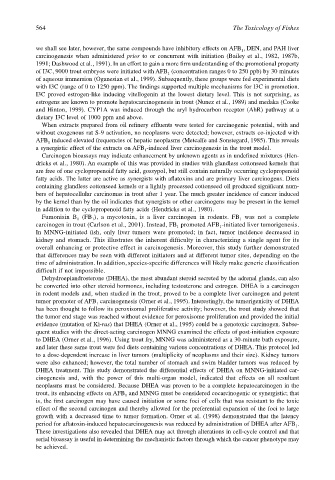Page 584 - The Toxicology of Fishes
P. 584
564 The Toxicology of Fishes
we shall see later, however, the same compounds have inhibitory effects on AFB , DEN, and PAH liver
1
carcinogenesis when administered prior to or concurrent with initiation (Bailey et al., 1982, 1987b,
1991; Dashwood et al., 1991). In an effort to gain a more firm understanding of the promotional property
of I3C, 9000 trout embryos were initiated with AFB (concentration ranges 0 to 250 ppb) by 30 minutes
1
of aqueous immersion (Oganesian et al., 1999). Subsequently, these groups were fed experimental diets
with I3C (range of 0 to 1250 ppm). The findings supported multiple mechanisms for I3C in promotion.
I3C proved estrogen-like inducing vitellogenin at the lowest dietary level. This is not surprising, as
estrogens are known to promote hepatocarcinogenesis in trout (Nunez et al., 1989) and medaka (Cooke
and Hinton, 1999). CYP1A was induced through the aryl hydrocarbon receptor (AhR) pathway at a
dietary I3C level of 1000 ppm and above.
When extracts prepared from oil refinery effluents were tested for carcinogenic potential, with and
without exogenous rat S-9 activation, no neoplasms were detected; however, extracts co-injected with
AFB induced elevated frequencies of hepatic neoplasms (Metcalfe and Sonstegard, 1985). This reveals
1
a synergistic effect of the extracts on AFB -induced liver carcinogenesis in the trout model.
1
Carcinogen bioassays may indicate enhancement by unknown agents as in undefined mixtures (Hen-
dricks et al., 1980). An example of this was provided in studies with glandless cottonseed kernels that
are free of one cyclopropenoid fatty acid, gossypol, but still contain naturally occurring cyclopropenoid
fatty acids. The latter are active as synergists with aflatoxins and are primary liver carcinogens. Diets
containing glandless cottonseed kernels or a lightly processed cottonseed oil produced significant num-
bers of hepatocellular carcinomas in trout after 1 year. The much greater incidence of cancer induced
by the kernel than by the oil indicates that synergists or other carcinogens may be present in the kernel
in addition to the cyclopropenoid fatty acids (Hendricks et al., 1980).
Fumonisin B (FB ), a mycotoxin, is a liver carcinogen in rodents. FB was not a complete
1
1
1
carcinogen in trout (Carlson et al., 2001). Instead, FB promoted AFB -initiated liver tumorigenesis.
1
1
In MNNG-initiated fish, only liver tumors were promoted; in fact, tumor incidence decreased in
kidney and stomach. This illustrates the inherent difficulty in characterizing a single agent for its
overall enhancing or protective effect in carcinogenesis. Moreover, this study further demonstrated
that differences may be seen with different initiators and at different tumor sites, depending on the
time of administration. In addition, species-specific differences will likely make generic classification
difficult if not impossible.
Dehydroepiandrosterone (DHEA), the most abundant steroid secreted by the adrenal glands, can also
be converted into other steroid hormones, including testosterone and estrogen. DHEA is a carcinogen
in rodent models and, when studied in the trout, proved to be a complete liver carcinogen and potent
tumor promoter of AFB carcinogenesis (Orner et al., 1995). Interestingly, the tumorigenicity of DHEA
1
has been thought to follow its peroxisomal proliferative activity; however, the trout study showed that
the tumor end stage was reached without evidence for peroxisome proliferation and provided the initial
evidence (mutation of Ki-ras) that DHEA (Orner et al., 1995) could be a genotoxic carcinogen. Subse-
quent studies with the direct-acting carcinogen MNNG examined the effects of post-initiation exposure
to DHEA (Orner et al., 1996). Using trout fry, MNNG was administered as a 30-minute bath exposure,
and later these same trout were fed diets containing various concentrations of DHEA. This protocol led
to a dose-dependent increase in liver tumors (multiplicity of neoplasms and their size). Kidney tumors
were also enhanced; however, the total number of stomach and swim bladder tumors was reduced by
DHEA treatment. This study demonstrated the differential effects of DHEA on MNNG-initiated car-
cinogenesis and, with the power of this multi-organ model, indicated that effects on all resultant
neoplasms must be considered. Because DHEA was proven to be a complete hepatocarcinogen in the
trout, its enhancing effects on AFB and MNNG must be considered cocarcinogenic or synergistic; that
1
is, the first carcinogen may have caused initiation or some foci of cells that was resistant to the toxic
effect of the second carcinogen and thereby allowed for the preferential expansion of the foci to large
growth with a decreased time to tumor formation. Orner et al. (1998) demonstrated that the latency
period for aflatoxin-induced hepatocarcinogenesis was reduced by administration of DHEA after AFB .
1
These investigations also revealed that DHEA may act through alterations in cell-cycle control and that
serial bioassay is useful in determining the mechanistic factors through which the cancer phenotype may
be achieved.

